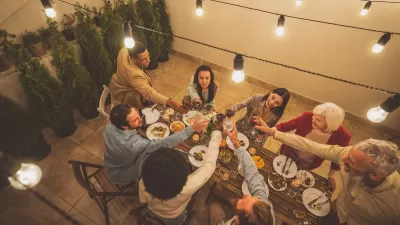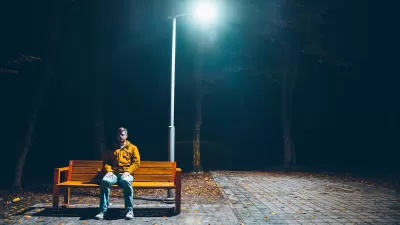Walkable neighborhoods, access to parks, and opportunities for social interaction can help reduce the burden of loneliness and promote community. But many of our cities aren’t built this way.

In an article in Streetsblog USA, Jennifer Kent, Emily J. Rugel and Marlee Bower, Emily J. Rugel, and Marlee Bower zoom out from the traditional view of loneliness as an individual problem to examine how urban design and the way we have built our cities contributes to a loss of social interaction.
The authors, who just completed a systematic review of research on loneliness and urban planning, identified factors that “can help people make connections,” including “housing design, transport systems and the distribution and design of open and natural spaces.”
The study found that living in small or poorly maintained housing can exacerbate loneliness by making people less likely to have friends over. “More universally, living in areas with good access to community centers and natural spaces helps people make social connections.” Additionally, access to public transit and active transportation options can also reduce loneliness and promote social interaction.
The authors also see a connection between socio-economic status and loneliness, largely because people with lower incomes tend to have less access to things like long-term housing they can personalize as their own, walkable neighborhoods, public parks, and other amenities that help reduce loneliness and improve mental health.
Ultimately, the authors conclude that context matters, and “there is no single built environment that is universally ‘good’ or ‘bad’ for loneliness.” But urban design and access to amenities can have a powerful influence on how people interact with others.
FULL STORY: Feeling Lonely? It's Not You, It's the Way We've Built our Nation

Alabama: Trump Terminates Settlements for Black Communities Harmed By Raw Sewage
Trump deemed the landmark civil rights agreement “illegal DEI and environmental justice policy.”

Planetizen Federal Action Tracker
A weekly monitor of how Trump’s orders and actions are impacting planners and planning in America.

The 120 Year Old Tiny Home Villages That Sheltered San Francisco’s Earthquake Refugees
More than a century ago, San Francisco mobilized to house thousands of residents displaced by the 1906 earthquake. Could their strategy offer a model for the present?

Ken Jennings Launches Transit Web Series
The Jeopardy champ wants you to ride public transit.

BLM To Rescind Public Lands Rule
The change will downgrade conservation, once again putting federal land at risk for mining and other extractive uses.

Indy Neighborhood Group Builds Temporary Multi-Use Path
Community members, aided in part by funding from the city, repurposed a vehicle lane to create a protected bike and pedestrian path for the summer season.
Urban Design for Planners 1: Software Tools
This six-course series explores essential urban design concepts using open source software and equips planners with the tools they need to participate fully in the urban design process.
Planning for Universal Design
Learn the tools for implementing Universal Design in planning regulations.
Clanton & Associates, Inc.
Jessamine County Fiscal Court
Institute for Housing and Urban Development Studies (IHS)
City of Grandview
Harvard GSD Executive Education
Toledo-Lucas County Plan Commissions
Salt Lake City
NYU Wagner Graduate School of Public Service





























